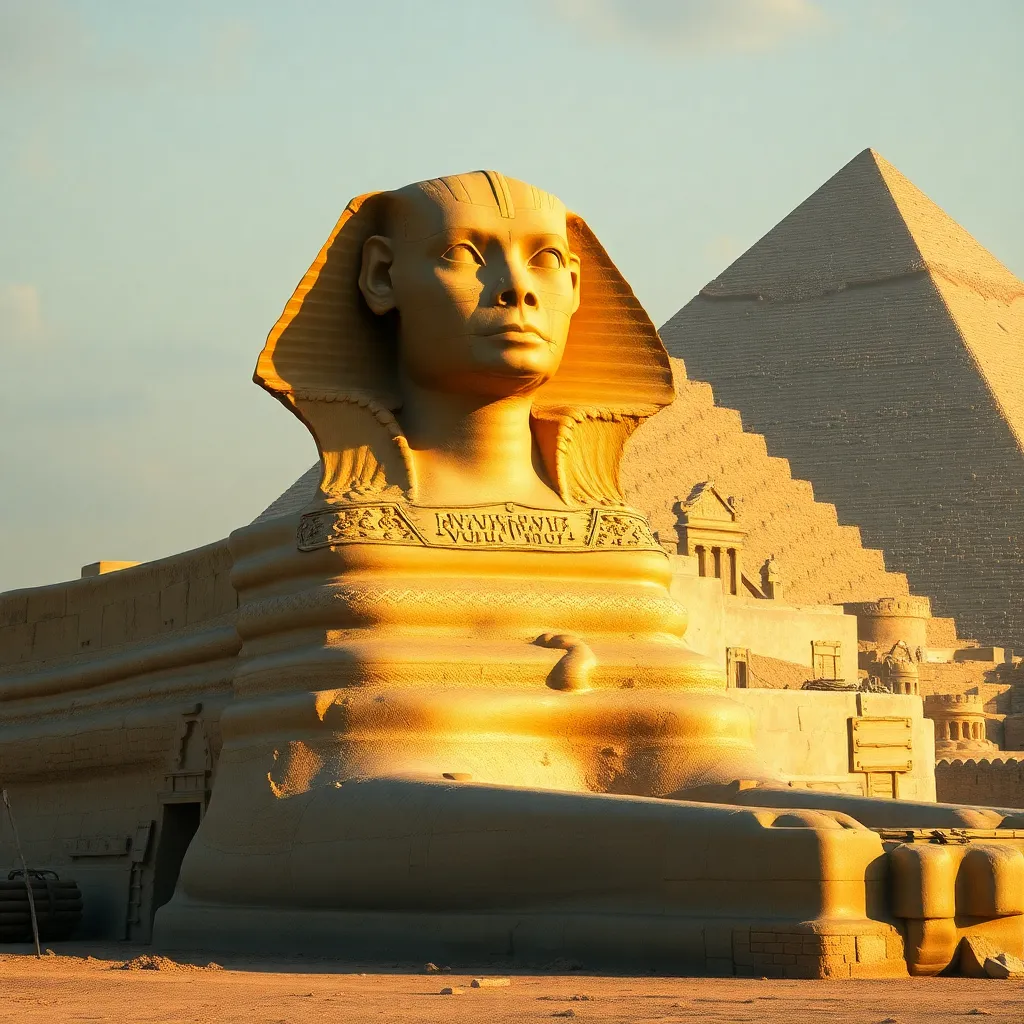The Sphinx and Its Role in the Pyramids’ Construction
I. Introduction
The Great Sphinx of Giza, an iconic symbol of ancient Egypt, stands sentinel over the Pyramids of Giza, one of the Seven Wonders of the Ancient World. Its enigmatic presence has captivated historians, archaeologists, and tourists alike. Understanding the relationship between the Sphinx and the Pyramids is crucial to appreciating the complexities of ancient Egyptian civilization.
This article aims to explore the historical context, architectural features, and symbolic significance of the Sphinx in relation to the construction of the Pyramids. Through a thorough examination, we will illuminate the Sphinx’s multifaceted role in this ancient civilization.
II. Historical Context of the Sphinx and Pyramids
The construction of the Sphinx and the Pyramids occurred during a remarkable period in Egyptian history known as the Old Kingdom, specifically the Fourth Dynasty (circa 2613–2494 BCE).
A. Timeline of construction
- Cheops (Khufu) Pyramid: circa 2580–2560 BCE
- Chephren (Khafre) Pyramid: circa 2570 BCE
- The Great Sphinx: believed to have been constructed around 2500 BCE
B. Cultural significance of the Sphinx in Ancient Egypt
The Sphinx was not merely a monumental sculpture; it represented the pharaoh’s power and served as a symbol of protection. Its lion’s body signified strength, while its human head symbolized intelligence and wisdom.
C. Overview of the Pyramid-building era
The period of pyramid building marked a time of significant advancements in engineering, architecture, and religious practices, showcasing the Egyptians’ ability to construct monumental structures that would last for millennia.
III. Architectural Features of the Sphinx
A. Design and dimensions
The Great Sphinx measures an astounding 73 meters (240 feet) long and 20 meters (66 feet) high, making it the largest monolithic statue in the world. The Sphinx’s face is believed to represent Pharaoh Khafre.
B. Materials used in construction
Constructed primarily from limestone, the Sphinx was carved directly from the Giza plateau’s bedrock. The choice of stone contributed to its durability and the ease of carving.
C. Symbolism of the Sphinx’s form
The combination of a lion’s body and a human head symbolizes the pharaoh’s role as both a powerful ruler and a wise leader, embodying the divine qualities necessary for leadership in ancient Egypt.
IV. Theories on the Sphinx’s Purpose
A. Guardian of the Giza Plateau
Many scholars believe the Sphinx served as a guardian of the Giza Plateau, protecting the Pyramids and the tombs of the pharaohs from intruders and evil spirits.
B. Solar and religious significance
In ancient Egyptian mythology, the Sphinx is often associated with the sun god Ra. Its alignment with the rising sun indicates its potential role in solar worship and religious ceremonies.
C. Role in funerary practices
The Sphinx may have also played a role in funerary practices, acting as a protector for the deceased pharaohs and ensuring their safe passage to the afterlife.
V. The Sphinx’s Relationship with the Pyramids
A. Spatial alignment and positioning
The Sphinx is strategically positioned in front of the Pyramid of Khafre, aligning with the celestial bodies and showcasing the Egyptians’ advanced understanding of astronomy.
B. Construction techniques and manpower
The construction of both the Sphinx and the Pyramids required vast manpower and innovative techniques, including the use of ramps and levers, which facilitated the movement of massive stone blocks.
C. Integration into the overall landscape
The Sphinx and Pyramids are not isolated monuments; they are part of a larger necropolis, including temples and smaller tombs, illustrating a cohesive religious and cultural landscape.
VI. Archaeological Discoveries and Research
A. Excavations and studies of the Sphinx
Numerous excavations have taken place around the Sphinx, revealing insights about its construction and the surrounding area. These studies have significantly contributed to our understanding of ancient Egyptian society.
B. Findings related to the Pyramids’ construction
Research has uncovered evidence of the workforce that built the Pyramids, including workers’ villages, burial sites, and tools, offering a glimpse into the lives of those who contributed to these monumental structures.
C. The impact of modern technology on understanding
Advanced technologies, such as ground-penetrating radar and 3D modeling, have allowed researchers to explore beneath the surface of the Sphinx and the Pyramids, revealing new information and challenging previous assumptions.
VII. Myths and Legends Surrounding the Sphinx
A. Ancient myths and their interpretations
The Sphinx has been the subject of various myths, including the tale of Oedipus, where the creature posed riddles to travelers. This myth has been interpreted in multiple ways, reflecting aspects of knowledge and power.
B. Modern misconceptions and theories
Many modern theories surround the Sphinx, including ideas about hidden chambers and lost civilizations. While some are rooted in truth, others are speculative and lack archaeological evidence.
C. The Sphinx in popular culture
From movies to literature, the Sphinx has been featured prominently in popular culture, often symbolizing mystery and enigma, further enhancing its allure in the modern imagination.
VIII. Conclusion
The Great Sphinx of Giza stands as a testament to the ingenuity and creativity of ancient Egyptian civilization. Its relationship with the Pyramids highlights the complex interplay of architecture, religion, and culture during the Old Kingdom. As research continues and new discoveries are made, our understanding of the Sphinx and its significance in pyramid construction will undoubtedly evolve.
Future research directions may focus on technological advancements in archaeology, further exploration of the surrounding areas, and interdisciplinary studies that combine history, engineering, and art. The enduring legacy of the Sphinx and the Pyramids continues to inspire awe and curiosity, reminding us of the incredible achievements of the ancient Egyptians.




